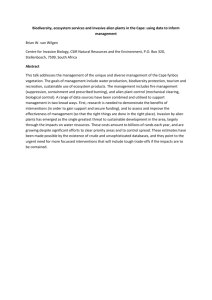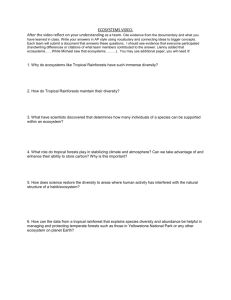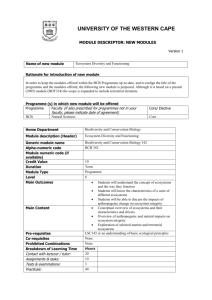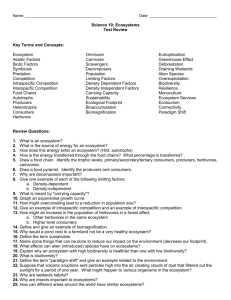Topic G_3 Impact of Humans on Ecosystems - wfs
advertisement
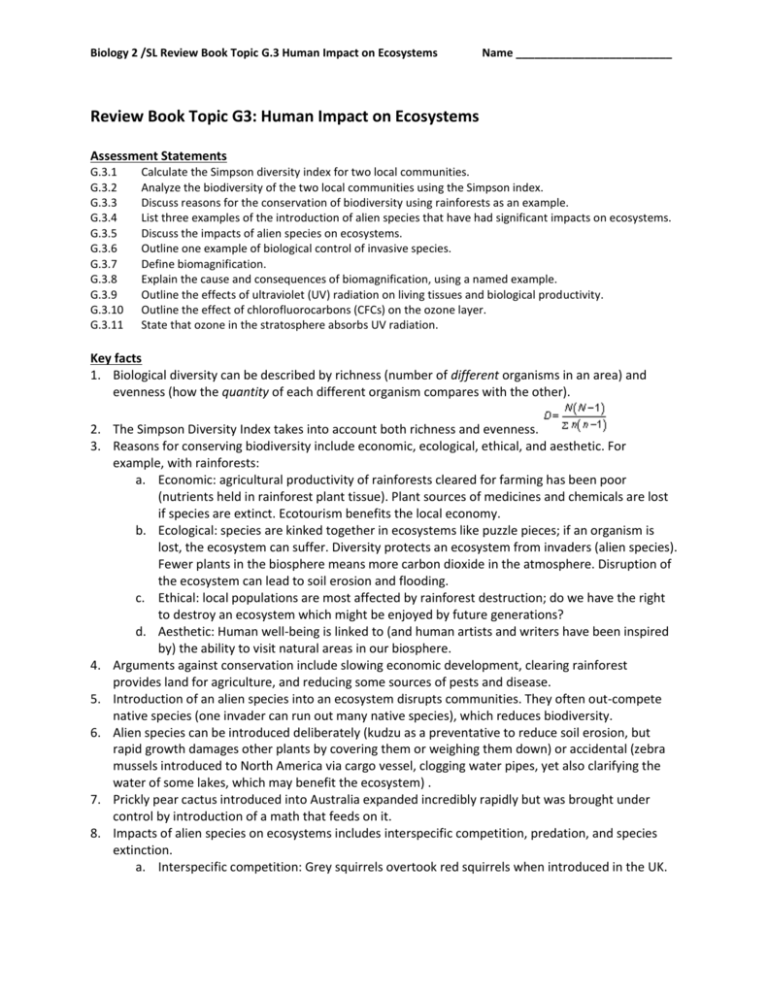
Biology 2 /SL Review Book Topic G.3 Human Impact on Ecosystems Name _________________________ Review Book Topic G3: Human Impact on Ecosystems Assessment Statements G.3.1 G.3.2 G.3.3 G.3.4 G.3.5 G.3.6 G.3.7 G.3.8 G.3.9 G.3.10 G.3.11 Calculate the Simpson diversity index for two local communities. Analyze the biodiversity of the two local communities using the Simpson index. Discuss reasons for the conservation of biodiversity using rainforests as an example. List three examples of the introduction of alien species that have had significant impacts on ecosystems. Discuss the impacts of alien species on ecosystems. Outline one example of biological control of invasive species. Define biomagnification. Explain the cause and consequences of biomagnification, using a named example. Outline the effects of ultraviolet (UV) radiation on living tissues and biological productivity. Outline the effect of chlorofluorocarbons (CFCs) on the ozone layer. State that ozone in the stratosphere absorbs UV radiation. Key facts 1. Biological diversity can be described by richness (number of different organisms in an area) and evenness (how the quantity of each different organism compares with the other). 2. The Simpson Diversity Index takes into account both richness and evenness. 3. Reasons for conserving biodiversity include economic, ecological, ethical, and aesthetic. For example, with rainforests: a. Economic: agricultural productivity of rainforests cleared for farming has been poor (nutrients held in rainforest plant tissue). Plant sources of medicines and chemicals are lost if species are extinct. Ecotourism benefits the local economy. b. Ecological: species are kinked together in ecosystems like puzzle pieces; if an organism is lost, the ecosystem can suffer. Diversity protects an ecosystem from invaders (alien species). Fewer plants in the biosphere means more carbon dioxide in the atmosphere. Disruption of the ecosystem can lead to soil erosion and flooding. c. Ethical: local populations are most affected by rainforest destruction; do we have the right to destroy an ecosystem which might be enjoyed by future generations? d. Aesthetic: Human well-being is linked to (and human artists and writers have been inspired by) the ability to visit natural areas in our biosphere. 4. Arguments against conservation include slowing economic development, clearing rainforest provides land for agriculture, and reducing some sources of pests and disease. 5. Introduction of an alien species into an ecosystem disrupts communities. They often out-compete native species (one invader can run out many native species), which reduces biodiversity. 6. Alien species can be introduced deliberately (kudzu as a preventative to reduce soil erosion, but rapid growth damages other plants by covering them or weighing them down) or accidental (zebra mussels introduced to North America via cargo vessel, clogging water pipes, yet also clarifying the water of some lakes, which may benefit the ecosystem) . 7. Prickly pear cactus introduced into Australia expanded incredibly rapidly but was brought under control by introduction of a math that feeds on it. 8. Impacts of alien species on ecosystems includes interspecific competition, predation, and species extinction. a. Interspecific competition: Grey squirrels overtook red squirrels when introduced in the UK. Biology 2 /SL Review Book Topic G.3 Human Impact on Ecosystems 9. 10. 11. 12. 13. 14. Name _________________________ b. Predation: a species which invades an ecosystem can eat another species. Sea lampreys from the ocean invaded the Great Lakes through the St. Lawrence Seaway, reducing the lake trout and whitefish populations. Salmon introduced into the Great Lakes eliminated smaller fish like alewives, which had also come from the ocean and spread out of control. c. 200 of 400 species of cichlids in Lake Victoria have been driven to extinction by introducing the Nile Perch to the lake. Biological control is the idea of using a natural predator to control an unwanted or invasive species. There is always risk involved in doing so. Purple loosestrife has invaded wetlands in the US and Canada. Produces 2 million seeds a year. Beetles are being introduced to control these populations. Phorid flies are being introduced to control red fire ant populations. Biomagnification is a process by which chemical substances become more concentrated at each trophic level. As consumer eat producers that have taken up chemicals, they become more concentrated in the consumer because they are soluble in fat and get stored in fatty tissue. DDT is an example of biomagnification. DDT in water DDT in zooplankton DDT in small fish DDT in large fish DDT in fish-eating osprey (millions of time greater concentration). The first sign of this problem was a reduction in predator bird populations (eggs of these birds were easily cracked). DDT was banned in 1971. Effects of ultraviolet (UV) radiation include non-lethal skin cancer, lethal skin cancer, mutation of DNA, sunburn, cataracts, and reduced biological productivity. Ozone is like a protective layer of sunscreen for the planet. Its presence in the stratosphere absorbs UV radiation. The ozone layer is thinning. Chlorofluorocarbons (CFCs) used in refrigerator coolants, propellants for aerosols, and for making packaging, were found to be the cause. This discovery led to an international ban on CFCs. CFCs break down to release chloride ions, which react with ozone molecules to produce ClO (chlorine monoxide) and Oxygen. The ClO reacts with an oxygen atom to form more oxygen and release a chloride ion. One CFC molecule can move up to the stratosphere in 15 years and remain there destroying ozone molecules for a century. Complete the following. 1. What do richness and evenness mean in terms of biological diversity? 2. Discuss the reasons for conservation of biodiversity. 3. What is an invasive species? Biology 2 /SL Review Book Topic G.3 Human Impact on Ecosystems Name _________________________ 4. What is biological control? 5. Describe the biological control of red fire ants. 6. Outline the effects of UV rays on living tissue and biological production. 7. Describe the effect of CFCs on the ozone layer.

